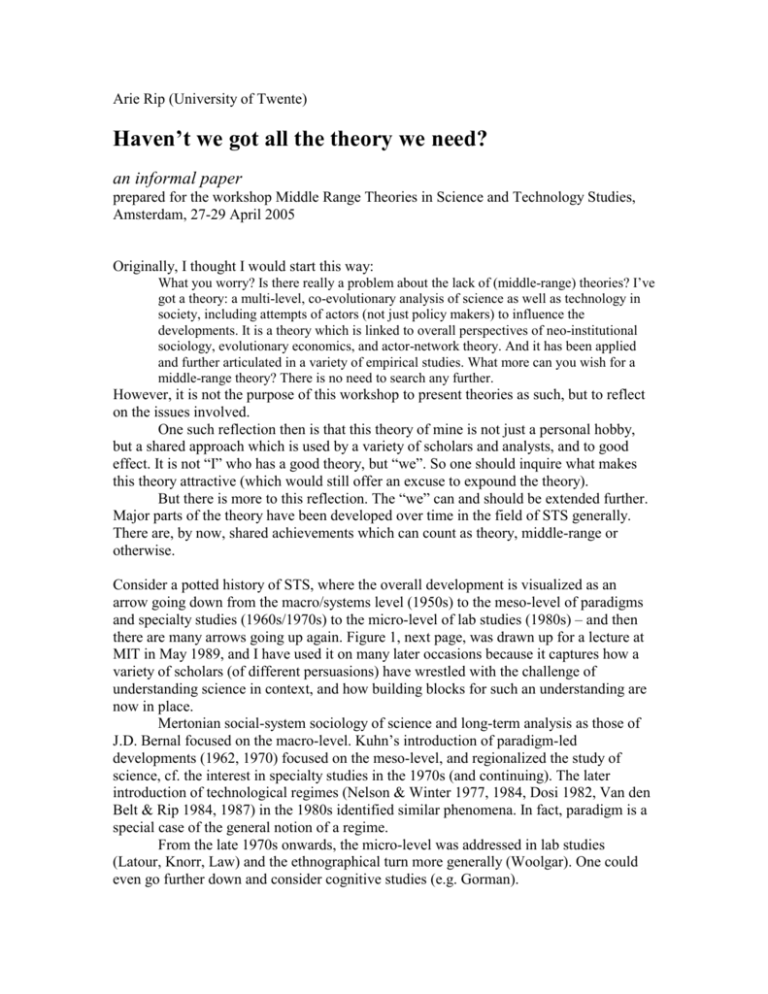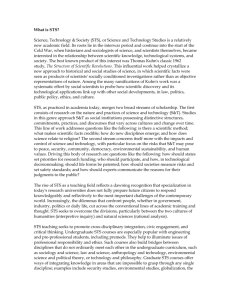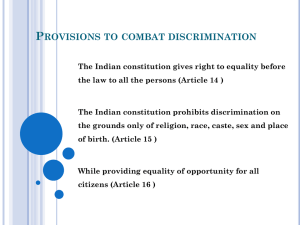Haven't we got all the theory we need?
advertisement

Arie Rip (University of Twente) Haven’t we got all the theory we need? an informal paper prepared for the workshop Middle Range Theories in Science and Technology Studies, Amsterdam, 27-29 April 2005 Originally, I thought I would start this way: What you worry? Is there really a problem about the lack of (middle-range) theories? I’ve got a theory: a multi-level, co-evolutionary analysis of science as well as technology in society, including attempts of actors (not just policy makers) to influence the developments. It is a theory which is linked to overall perspectives of neo-institutional sociology, evolutionary economics, and actor-network theory. And it has been applied and further articulated in a variety of empirical studies. What more can you wish for a middle-range theory? There is no need to search any further. However, it is not the purpose of this workshop to present theories as such, but to reflect on the issues involved. One such reflection then is that this theory of mine is not just a personal hobby, but a shared approach which is used by a variety of scholars and analysts, and to good effect. It is not “I” who has a good theory, but “we”. So one should inquire what makes this theory attractive (which would still offer an excuse to expound the theory). But there is more to this reflection. The “we” can and should be extended further. Major parts of the theory have been developed over time in the field of STS generally. There are, by now, shared achievements which can count as theory, middle-range or otherwise. Consider a potted history of STS, where the overall development is visualized as an arrow going down from the macro/systems level (1950s) to the meso-level of paradigms and specialty studies (1960s/1970s) to the micro-level of lab studies (1980s) – and then there are many arrows going up again. Figure 1, next page, was drawn up for a lecture at MIT in May 1989, and I have used it on many later occasions because it captures how a variety of scholars (of different persuasions) have wrestled with the challenge of understanding science in context, and how building blocks for such an understanding are now in place. Mertonian social-system sociology of science and long-term analysis as those of J.D. Bernal focused on the macro-level. Kuhn’s introduction of paradigm-led developments (1962, 1970) focused on the meso-level, and regionalized the study of science, cf. the interest in specialty studies in the 1970s (and continuing). The later introduction of technological regimes (Nelson & Winter 1977, 1984, Dosi 1982, Van den Belt & Rip 1984, 1987) in the 1980s identified similar phenomena. In fact, paradigm is a special case of the general notion of a regime. From the late 1970s onwards, the micro-level was addressed in lab studies (Latour, Knorr, Law) and the ethnographical turn more generally (Woolgar). One could even go further down and consider cognitive studies (e.g. Gorman). Figure 1: Developments in science studies up to 1990 What happened after 1990 is that micro- and meso-level studies were increasingly put in context, linked to newly emerging themes like national research systems, public legitimation of science, experts and public debate. Thus, back to the macro, but with the advantage of the insights from specialty studies and lab studies. In other words, STS as a whole was doing multi-level analysis, even when individual scholars and groups might focus on one level or one theme only. In addition, long-term developments became a theme, fuelled recently by the discussion of changing modes of knowledge production (Gibbons et al. 1994 was the catalyst, but is definitely not the last word), and even more recently by the interest in regime change and transitions (especially transitions towards sustainability, cf. Elzen, Geels & Green 2005, and ongoing work in Germany and the Netherlands). What we have here is a theory, and one which qualifies as middle-range in Merton’s definition: no overarching abstract theory, but linked to a variety of empirical work. It is now available in STS as a shared resource even if it has not been written up as such. This theory is somewhat independent of the so-called ‘grand theories’ like ANT and SCOT – which are really perspectives, not theories. The theory is primarily a phenomenological theory, and can still link up with various explanatory theories. I am not saying that STS is unified by this theory. There are differences, of course, but these depend more on what is foregrounded and what is backgrounded, than on major theoretical clashes. Even if we like to debate and polemicize among ourselves, from a general social science and history point of view, the similarities within STS are more striking than the differences. Let me pursue this further, because the similarities derive from the “nature” of our object (or at least, entrance point), science and technology. Even if one of our recurrent claims is that science and technology are not special, somehow removed from the life of humans and things, one can still inquire into the characteristics of science and technology without ascribing some essence to them. One key characteristic then is the introduction of novelty, in particular novel sociotechno-cognitive configurations. This is not the prerogative of science and technology,1 but in modern societies it is their mandate, and a large part of their ‘business’ is to nurture the ‘hopeful monstrosities’ into an independent existence. Work on creation and introduction of novelties implies some de-alignment with respect to existing orders, while at the same time attempts at re-alignment take place and have effects (including unintended effects). Irreversibilities emerge (cf. the notion of path dependency), also at the collective level (exemplars and dominant designs, paradigms and regimes more generally), and impacts are co-produced (cf. Rip on Constructive TA, Jasanoff 2004). Clearly, the phenomenological theory implies an interest in processes and interactions, without neglecting (emerging) structures. This entails a new take on institutionalisation because cognitive and technical elements are now an integral part. In my view, an actor-network version of structuration theory (Giddens) is in order, which allows content or substance of developments to be taken into account in an integral 1 Novelties are not unique to science and technology, the occurrence of variations is a general phenomenon of social life, and agency can be positioned as introducing variation rather than putting the aspect of intentional action up front. Novelties may not always become visible, because variations are often transformed back into the regular (cf. repair work as studied in symbolic interactionism) or excluded or otherwise made invisible. Whether variations remain visible and have effects depends on the constellation in which they occur: selective co-evolution in the small. An interesting example of variation-in-context is how on 1 December 1955 Rosa Parks, a black lady from Montgomery (Alabama), sat down in the bus on a place reserved for whites. She was forced to get off the bus, and this sparked off the bus protest movement. Hundreds or thousands of black persons had had this experience without anything much happening. Now, the circumstances were right, and other actors in the situation, notably in the nascent civil rights movement in Alabama (and later more widely) who could use Rosa Parks as a case for their cause, co-produced the effect. Lovell 2003 quotes the common storyline focusing on an individual act of courage that triggers collective display of defiance. Schuyt 1972 has emphasized the incidental character of the action itself, noting that Rosa Parks had no intention to protest, she was just too tired to remain standing. Whatever the intentions, a “lateral action” occurred, across rather than against the existing order. Lovell 2003 adds that Rosa Parks did have a history in human rights activities, and then shows that she, rather than other blacks who suffered this treatment, was selected as “standard bearer” because she was working class and respectable. manner. Actually, it is already in place but as a mosaic rather than an explicit theory, and it provides a framework for the plethora of case studies that continue to be done.2 The combination of process approaches and multi-level analysis creates a dynamic version of the theory where alignment between levels becomes an important theme, in the small as when Fujimura analyses alignment between bench work, the institution and various sponsors, and in the large as when social contracts of science are analysed as alignment of search regimes and research institutions with government and politics.3 This then also allows a better take on long-term developments. Multi-level analysis has already shown how the role of sponsors (which are essential to science and technology because working on novelties does not offer immediate returns) can be understood. Van der Meulen, Guston, and Morris have shown the usefulness of a sociological version of principal-agent analysis to understand the dynamics of the world of science and science policy. One can also trace the importance of sponsors in the emergence of modern science, their backgrounding when the welfare state became a general sponsor of science, and the present “return” of the sponsors (Rip). Another part of the multi-level dynamics are the claims and promises that are offered about new scientific findings and technological options, if only to mobilise resources. These have repercussions on ongoing work, without fully determining it (and can lead to hype-disappointment cycles, as occurred in ICT and may well occur in nanotechnology). Expectation dynamics are also an entrance point into general theory, indicating the force of what we have called ‘prospective structures’ (Van Lente and Rip 1998). These are not only a key part of a techno-cognitive structuration theory, but are visible in various concrete studies and interventions. This combination is visible in the notion of ‘actor-worlds’ discussed by Callon (Callon et al. 1986) and further taken up in ‘future scripts’ (De Laat), and in the sociotechnical scenarios which are a key part of Constructive Technology Assessment. So how far have “we” come? Clearly, there are major achievements. There are also limitations which become visible exactly because of the recognition of what STS has been able to achieve. An indication is the uneasy relationship with social, economic and political sciences, where “we” tend to neglect to take their insights into account. This criticism holds even when there are good reasons to not accept these insights wholesale, because of their 2 I refer to actor-network theory here. If the other ‘grand theory’, SCOT, is to be included, it must be as societal rather than social construction, and be positioned as part of co-evolution of science, technology and society. 3 However important alignment is for development and success, there is also the issue of too rapid alignment, possibly in a less desirable direction, or in any case so soon that not enough learning has occurred. Stabilization of patterns, and of emerging irreversibilities more generally, could create a lock-in which is difficult to escape. In the case of recent changes in and around science I have argued that the regime of Strategic Science might be closing upon itself too soon, because of strong economic and decision-making pressures to deliver, and to exclude alternative, or just different approaches, like community-oriented research and indigenous knowledges. Without necessarily pronouncing on the value of these approaches per se, I argue that they play a role in maintaining heterogeneity (Rip 2000). neglect of novelty & process, and dynamic multi-level analysis.4 But there are interesting areas of theory and empirical studies, like actor-centred institutionalism (e.g. Schimank 1988, 1992), and German studies more generally, if one forgives them their bias towards systems approaches. Even for anthropology, which is the most congenial to STS, there is insufficient attention in STS to the relevance of its general insights and understandings. A further limitation is the tendency to consider policy and economic factors as external to the dynamics of science and technology, impacting on them, distorting them (cf. Elzinga 1985 on epistemic drift), and being turned into occasions for critical analysis. Instead, I would argue for endogenizing policy, economics etc and attempting an integral approach. This is where the still programmatic notion of co-evolution can be helpful (cf. Rip 2002). A further step in turning a limitation of the theory as presently available in STS into an occasion for improving on it is to consider reflexive co-evolution: the increasing reflexivity of the co-evolution of science, technology and society. The rise of explicit science policy making (since the Sputnik shock of 1957) is a first indicator. Technology assessment, debated expertise, and participation are recent phenomena, and have become accepted as a necessary element (Rip 2002). Such reflexivity is not just a matter of discourse and debate, even if that is part of it.5 It is about institutionalized feedback relations which handle – in this case – interactions between science, technology and society. In other words, the de facto governance arrangements become reflexive. Such reflexivity can be welcomed as a desirable development, somewhat independent of the nature of the actual arrangements and the outcomes. STS scholars are part of reflexive co-evolution, unavoidably so. They can make the unintended effects (Beck) visible, show the “overflowing” (Callon) and point out the “hybrid monsters” (Latour). Increasingly, STS scholars involve themselves in the coevolution, attempting to critically analyse and/or improve it, or even collaborating with science and technology actors. 4 With some reinterpretation, less process-oriented heories, often methodological-individualist or even rational choice (e.g. principal/agent analysis) can still be used, as in this example from a Chapter I wrote on co-evolutionary approaches to reflexive governance: “For our actors, there is the experience of effects of co-evolution in terms of constraints, uncertainties, and multi-actor, multi-level dynamics: mutual interdependencies, the force of path dependency, anticipation on selection, as well as, even more precariously, anticipation on emerging patterns (the struggle for an industry standard is an obvious example). Intentional and strategic action contributes to the co-evolution and the patterns which structure action, even if the resulting patterns may not be desired by any of the actors. These emerge ‘behind their backs’ as it were. Using the well-known boat-like diagram of Coleman, where individual actions add up to patterns at the collective level (Coleman 1990), this can be phrased as: actors jostling in the bow of Coleman’s boat, and so moving it ahead and creating structures larger than themselves in that movement.” 5 There is a link with Beck’s diagnosis of reflexive modernity as modernity confronted with its own, more or less unintended effects. Beck contrasts reflexive with reflective, the latter indicating reflection on what is happening. If such reflection is part of further action and interaction, it would enhance reflexivity. Jan-Peter Voß adds to this (personal communication, 2004): There is first-order reflexivity, the self-shaping or selfconstituting nature of a societal arrangement via feedback from its own action in and on the world. But then also (in late modernity), second-order-reflexivity. Society adapts to this constellation, knowingly and unknowingly, it is shaped by its experience of unintended feedback. This is visible in how forms of knowledge production, technology development, governance etc. are developed that reflect the need to deal with (the possibility) of such feedbacks. With the recent institutionalized interest in ELSA [Ethical, Legal and Social Aspects/Issues] in the Human Genome Program since the early 1990s, and now more widely, also in nanotechnology initiatives, STS can become the victim of ‘ELSIfication’.6 Quite a number of well-known STS scholars (including myself) appear to rush into alliances with scientists and technologists – hopefully with their eyes open. This is where good theory has to come in again: not just as a scholarly achievement, but as a way to understand the situation and so position yourself better. So we are back where we started. Do we have a good enough theory? My argument in this paper has been that STS as a field does have a good phenomenological theory, even if background perspectives are still occasion for debate (we like debate). This phenomenological theory already leads to useful diagnoses of what is happening, as well as offers entrance points for general social science theory and approaches to enrich STS. This is one key component of STS in the 2000s (and can be seen as the productive version of the ongoing mainstreaming of STS, where regular disciplines take up the study of STS). The other key component is reflexivity-in-action. Reflexivity has been positioned as a weakness (e.g. in the UK STS debates in the 1970s and 1980s), undermining critical action. The sophisticated reflexivity exercises of Mulkay, Ashmore, Woolgar etc in the 1980s, playing with authorship and voices in the text, remained empty. By now, however, reflexivity has become serious business (to paraphrase the 2004 and 2005 Oxford workshops theme Does STS mean business?). This is a research site for further development of what I called the phenomenological theory embedded in the evolving field of STS. Bibliography (incomplete) Beck, Ulrich, Risk Society. Towards a New Modernity, London: Sage, 1992. Elzinga, Aant, ‘Research, Bureaucracy and the Drift of Epistemic Criteria’, in Björn Wittrock and Aant Elzinga (eds), The University Research System. The Public Policies of the Home of Scientists, Stockholm: Almqvist & Wiksell International, 1985, pp. 191-220. 6 See for an early warning, Howard Newby (1992): “The wider public (..). Its role is reduced to that of hapless bystander or, later, the recipient of scientific advance and technological innovation which the scientific community believes it ought to want. If the public decides it does not want it, it is regarded as either ignorant or irrational. (This is the point at which the natural science community appeals to social scientists to help lubricate the public acceptability of science and technological change.) [in contrast] I am seeking to demonstrate that social science is an integral, and not merely a marginal, activity in understanding the process whereby scientific excellence and technological innovation may lead to economic and social well-being. For this to be effective, social science investigation should not be restricted to the down-stream study of impacts and diffusion, but should be integrated into the study of the very processes themselves. Social and natural scientists have complementary skills, and mutual interests, intogether improving the processes of technological innovation. This will involve a degree of multidisciplinarity, if not inter-disciplinarity, which spans not only the social sciences, but transcends the two cultures.” Jasanoff, Sheila (ed.), States of Knowledge. The co-production of science and social order, London: Routledge, 2004. Lovell, Terry (2003), ‘Resisting with Authority: Historical Specificity, Agency and the Performative Self’, Theory, Culture & Society, 20 (2003) 1-17 Morris, Norma, Biomedical research in changing contexts: an analysis of the agents, PhD Thesis, University of Twente, 2004. Howard Newby, 'One society, one Wissenschaft: a 21st century vision', Science and Public Policy, 19(1) Feb 1992, 7-14. Rip, Arie (2002), A co-evolutionary perspective on ELSI, CTA and other attempts at recontextualisation of science and technology in society. Paper presented to the meeting of the European Association for the Study of Science and Technology, York, 31 July – 3 August 2002. Uwe Schimank, Gesellschaftliche Teilsysteme als Akteurfiktionen, Kölner Zeitschrift für Soziologie und Sozialpsychologie, 40 (1988) 619-639. Uwe Schimank, Spezifische Interessenkonsense trotz generellen Orientierungsdissens. Ein Integrationsmechanismus polyzentrischer Gesellschaften. in Giegel, Hans-Joachim (Hrsg) Kommunikation und Konsens in moderne Gesellschaften, Frankfurt/M: Suhrkamp, 1992 Schuyt, C.J.M., Recht, orde en burgerlijke ongehoorzaamheid, Rotterdam: Universitaire Pers Rotterdam, 1972. Steve Woolgar (ed.), Knowledge and Reflexivity. New Frontiers in the Sociology of Knowledge (London: Sage, 1988)





